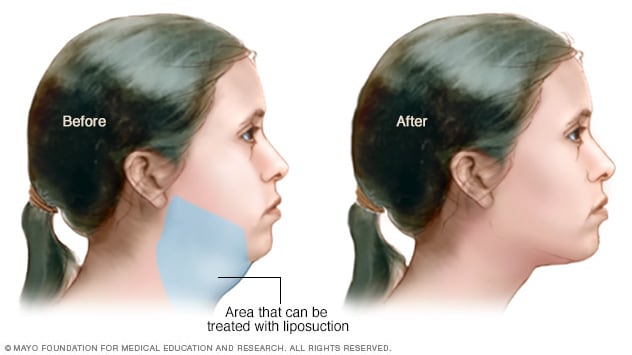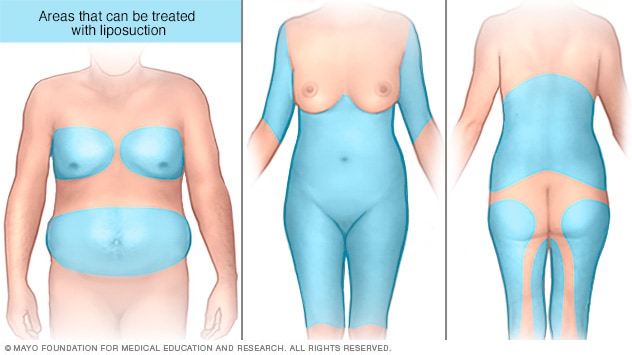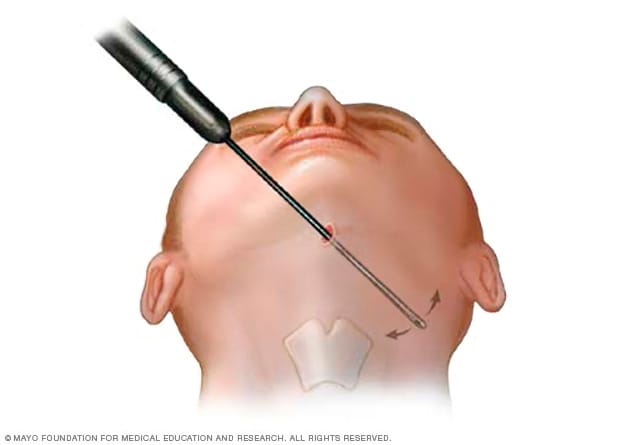Liposuction, or simply lipo, is a type of fat removal procedure used in plastic surgery. Evidence does not support an effect on weight beyond a couple of months and it does not appear to affect obesity related problems. In the United States it is the most commonly done cosmetic surgery.
The procedure may be performed under general, regional, or local anesthesia. It then involves using a cannula and negative pressure to suck out fat. It is believed to work best on people with a normal weight and good skin elasticity.
Overview
Liposuction is a surgical procedure that uses a suction technique to remove fat from specific areas of the body, such as the abdomen, hips, thighs, buttocks, arms or neck. Liposuction also shapes (contours) these areas. Other names for liposuction include lipoplasty and body contouring.
Liposuction isn’t typically considered an overall weight-loss method or a weight-loss alternative. If you’re overweight, you’re likely to lose more weight through diet and exercise or through bariatric procedures — such as gastric bypass surgery — than you would with liposuction.
You may be a candidate for liposuction if you have too much body fat in specific spots but otherwise have a stable body weight.
Why it’s done
Liposuction is used to remove fat from areas of the body that haven’t responded to diet and exercise, such as the:
•Abdomen
•Upper arms
•Buttocks
•Calves and ankles
•Chest and back
•Hips and thighs
•Chin and neck
In addition, liposuction can sometimes be used for breast reduction or treatment of gynecomastia.
When you gain weight, fat cells increase in size and volume. In turn, liposuction reduces the number of fat cells in a specific area. The amount of fat removed depends on the appearance of the area and the volume of fat. The resulting contour changes are generally permanent — as long as your weight remains stable.
After liposuction, the skin molds itself to the new contours of the treated areas. If you have good skin tone and elasticity, the skin is likely to appear smooth. If your skin is thin with poor elasticity, however, the skin in the treated areas may appear loose.
Liposuction doesn’t improve cellulite dimpling or other skin surface irregularities. Likewise, liposuction doesn’t remove stretch marks.
To be a candidate for liposuction, you must be in good health without conditions that could complicate surgery — such as restricted blood flow, coronary artery disease, diabetes or a weak immune system.
What you can expect
Before the procedure
Before your liposuction procedure, the surgeon may mark circles and lines on the areas of your body to be treated. Photos also may be taken so that before and after images can be compared.
How your liposuction procedure is done depends on the specific technique that’s used. Your surgeon will select the appropriate technique based on your treatment goals, the area of your body to be treated, and whether you have had other liposuction procedures in the past.
Tumescent liposuction. This is the most common type of liposuction. The surgeon injects a sterile solution — a mixture of salt water, which aids fat removal, an anesthetic (lidocaine) to relieve pain and a drug (epinephrine) that causes the blood vessels to constrict — into the area that’s being treated. The fluid mixture causes the affected area to swell and stiffen.
The surgeon then makes small cuts into your skin and inserts a thin tube called a cannula under your skin. The cannula is connected to a vacuum that suctions fat and fluids from your body. Your body fluid may be replenished through an intravenous (IV) line.
- Ultrasound-assisted liposuction (UAL). This type of liposuction is sometimes used in conjunction with traditional liposuction. During UAL, the surgeon inserts a metal rod that emits ultrasonic energy under your skin. This ruptures the fat-cell walls and breaks down the fat for easier removal. A new generation of UAL called VASER-assisted liposuction uses a device that may improve skin contouring and reduce the chance of skin injuries.
- Laser-assisted liposuction (LAL). This technique uses high-intensity laser light to break down fat for removal. During LAL, the surgeon inserts a laser fiber through a small incision in the skin and emulsifies fat deposits. The fat is then removed via a cannula.
- Power-assisted liposuction (PAL). This type of liposuction uses a cannula that moves in a rapid back-and-forth motion. This vibration allows the surgeon to pull out tough fat more easily and faster. PAL may sometimes cause less pain and swelling and can allow the surgeon to remove fat with more precision. Your surgeon may select this technique if large volumes of fat need to be removed or if you’ve had a previous liposuction procedure.
Results
After liposuction, swelling typically subsides within a few weeks. By this time, the treated area should look less bulky. Within several months, expect the treated area to have a leaner appearance.
It’s natural for skin to lose some firmness with aging, but liposuction results are generally long lasting as long as you maintain your weight. If you gain weight after liposuction, your fat distribution may change. For example, you may accumulate fat around your abdomen regardless of what areas were originally treated.



